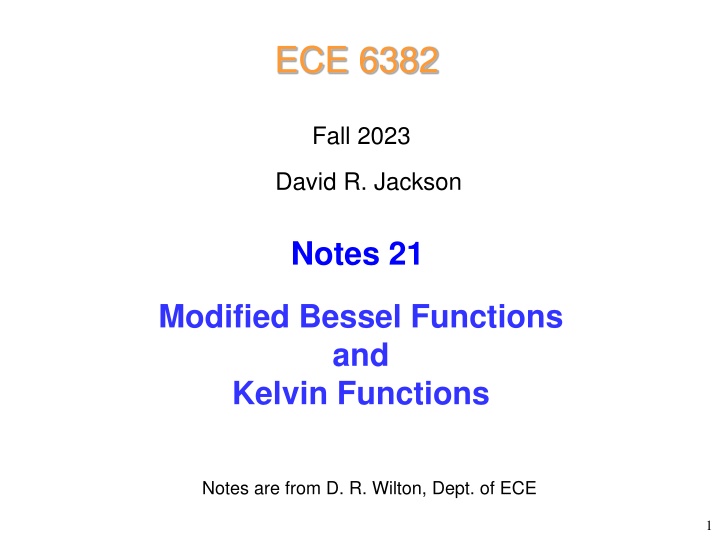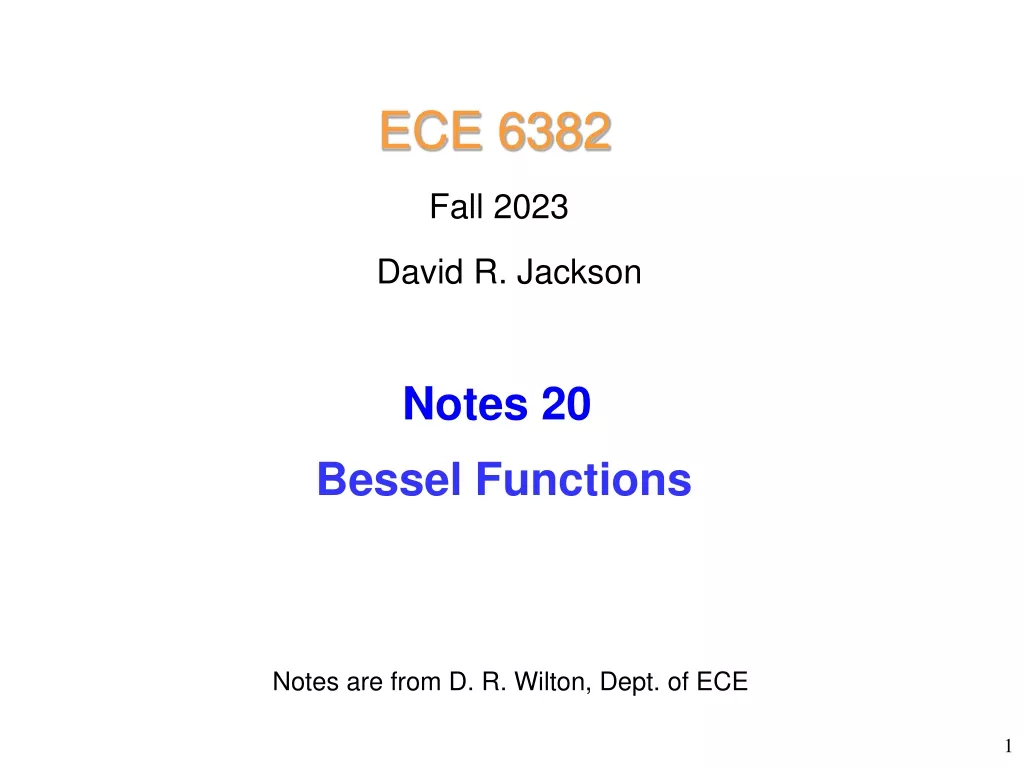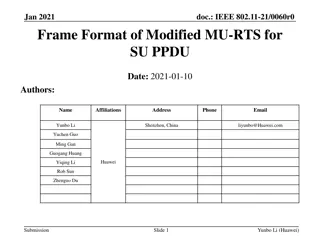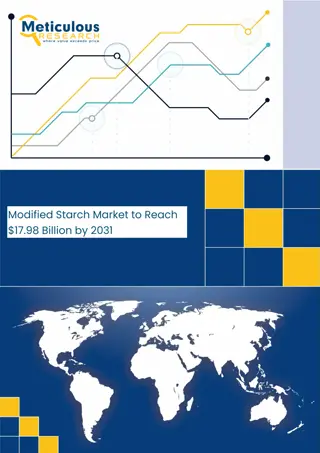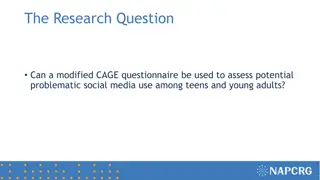Modified Bessel Functions and Kelvin Functions Overview
In this set of notes, we delve into Modified Bessel Functions and Kelvin Functions, exploring their properties, differential equations, and relationships with regular Bessel functions. The content covers definitions, solutions, approximations, and graphical representations of these special functions.
Download Presentation

Please find below an Image/Link to download the presentation.
The content on the website is provided AS IS for your information and personal use only. It may not be sold, licensed, or shared on other websites without obtaining consent from the author.If you encounter any issues during the download, it is possible that the publisher has removed the file from their server.
You are allowed to download the files provided on this website for personal or commercial use, subject to the condition that they are used lawfully. All files are the property of their respective owners.
The content on the website is provided AS IS for your information and personal use only. It may not be sold, licensed, or shared on other websites without obtaining consent from the author.
E N D
Presentation Transcript
ECE 6382 Fall 2023 David R. Jackson Notes 21 Modified Bessel Functions and Kelvin Functions Notes are from D. R. Wilton, Dept. of ECE 1
Modified Bessel Functions Modified Bessel differential equation: 2 d y dx dy dx + + = 2 2 2 ( ) 0 x x x y 2 This comes from the usual Bessel differential equation: d y dy z z z dz dz 2 + + = 2 2 2 ( ) 0 y (Bessel DE) 2 = = ; : z ix dz idx Set in the usual Bessel DE 2 d y dx dy dx + + = 2 2 2 ( ) 0 x x x y (modified Bessel DE) 2 The modified Bessel functions are Bessel functions of imaginary argument. ( ) ( , J ix Y ix ) ( ) 2
Modified Bessel Function of the First Kind Definition: ( ) ( ) x ( ) ix I i J (I is a real function of x.) To see that I is a real function, use the Frobenius solution for J : ( ( ) k + 2 k 1 + ix Note : = ( ) J ix ) ( ) i ( ) 2 k k ! ! 2 k k = 1 = 0 k ( ) ( ) i ( ) 1 = = 1 i Therefore, the Frobenius series solution for I is: + 2 k 1 x = ( ) x I ( ) + ! ! 2 k k = 0 k 3
Second Solution of Modified Bessel Equation For n, the modified Bessel function of the 2nd kind is defined as: ( ) sin ( ) x I x I ( ) x K 2 For = n (an integer): ( ) sin ( ) x I x I ( ) x lim K n 2 n 4
Relations Between Bessel and Modified Bessel Functions The modified Bessel functions are related to the regular Bessel functions as ( ) ( ) x ( ) ( ) sin I i J ix ( ) x I x I ( ) x ( ) ( ix ) + = 1 (1) K i H proof omitted 2 2 Note: The added factors in front ensure that the functions are real. ( ) ( ) n ( ) x K = I x I = For an integer: n n , n ( ) x = K x n 5
Small Argument Approximations For small arguments we have: 1 x ( ) x I ( ) 0 x ! 2 x ( ) x ln K 0 0 x 2 ( ) 1 ! x ( ) x K 0 x 2 2 6
Large Argument Approximations For large arguments we have: x e ( ) x I exponentially grows! x 2 x ( ) x exponentially decays! x K e x 2 x 7
Plots of Modified Bessel Functions for Real Arguments I0 I1 I2 x The In functions increase exponentially. They are finite at x = 0. 8
Plots of Modified Bessel Functions for Real Arguments K1 K2 K0 x The Kn functions decrease exponentially. The are infinite at x = 0. 9
Recurrence Relations Some recurrence relations are: 2 = ( ) x ( ) x ( ) x I I I + 1 1 x I + = ( ) x ( ) x 2 ( ) x I I + 1 1 2 = ( ) x ( ) x ( ) x K K K + 1 1 x K x ( ) + = ( ) x ( ) x 2 K K + 1 1 10
Wronskian A Wronskian identity is: 1 x ( ) ( ) x K x = = , ( ) x K x ( ) W I K I I 11
Kelvin Functions The Kelvin functions are defined as ( ( ) ) ( ( ) ) ( ) ( ) x 3 /4 i Ber Re x J xe 3 /4 i Bei Im J xe ( ( ) ) ( ( ) ) ( ) ( ) x /4 i Ker Re x K xe /4 i Kei Im K xe Note: These are important for studying the fields inside of a conducting wire. 12
Kelvin Functions (cont.) The Ber functions increase exponentially. They are finite at x = 0. Ber0 Ber1 Ber2 x 13
Kelvin Functions (cont.) The Bei functions increase exponentially. They are finite at x = 0. Bei1 Bei2 Bei0 x 14
Kelvin Functions (cont.) Normalizing makes it more obvious that the Ber and Bei functions increase exponentially and also oscillate as x increases. ( ) x Ber 1 0 / 2 x e x x x 15
Kelvin Functions (cont.) Normalizing makes it more obvious that the Ber and Bei functions increase exponentially and also oscillate as x increases. ( ) x Bei 1 0 / 2 x e x x x 16
Kelvin Functions (cont.) The Ker functions decay exponentially. They are infinite at x = 0. Ker0 Ker1 x 17
Kelvin Functions (cont.) The Kei functions decay exponentially. They are infinite at x = 0. Kei1 x 18
Kelvin Functions (cont.) Normalizing makes it more obvious that the Ker and Kei functions decrease exponentially and also oscillate as x increases. 2 1.252 1 ( ) x Ker 1 x 0 / 2 x e F x ( ) 0 1 1.252 2 0 20 40 60 80 100 xx 0 100 19
Kelvin Functions (cont.) Normalizing makes it more obvious that the Ker and Kei functions decrease exponentially and also oscillate as x increases. 2 1.252 1 ( ) x Kei 1 0 G x ( ) 0 / 2 x e x 1 1.252 2 0 20 40 60 80 100 x 0 x 100 20
